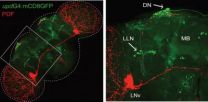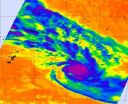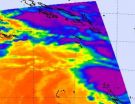(Press-News.org) LA JOLLA, CA -- Scientists at The Scripps Research Institute in California and the Technion–Israel Institute of Technology have developed a "biological computer" made entirely from biomolecules that is capable of deciphering images encrypted on DNA chips. Although DNA has been used for encryption in the past, this is the first experimental demonstration of a molecular cryptosystem of images based on DNA computing.
The study was published in a recent online-before-print edition of the journal Angewandte Chemie.
Instead of using traditional computer hardware, a group led by Professor Ehud Keinan of Scripps Research and the Technion created a computing system using bio-molecules. When suitable software was applied to the biological computer, it could decrypt, separately, fluorescent images of The Scripps Research Institute and Technion logos.
A Union Between Biology and Computer Science
In explaining the work's union of the often-disparate fields of biology and computer science, Keinan notes that a computer is, by definition, a machine made of four components—hardware, software, input, and output. Traditional computers have always been electronic, machines in which both input and output are electronic signals. The hardware is a complex composition of metallic and plastic components, wires, and transistors, and the software is a sequence of instructions given to the machine in the form of electronic signals.
"In contrast to electronic computers, there are computing machines in which all four components are nothing but molecules," Keinan said. "For example, all biological systems and even entire living organisms are such computers. Every one of us is a biomolecular computer, a machine in which all four components are molecules that 'talk' to one another logically."
The hardware and software in these devices, Keinan notes, are complex biological molecules that activate one another to carry out some predetermined chemical work. The input is a molecule that undergoes specific, predetermined changes, following a specific set of rules (software), and the output of this chemical computation process is another well-defined molecule.
"Building" a Biological Computer
When asked what a biological computer looks like, Keinan laughs.
"Well," he said, "it's not exactly photogenic." This computer is "built" by combining chemical components into a solution in a tube. Various small DNA molecules are mixed in solution with selected DNA enzymes and ATP. The latter is used as the energy source of the device.
"It's a clear solution—you don't really see anything," Keinan said. "The molecules start interacting upon one another, and we step back and watch what happens." And by tinkering with the type of DNA and enzymes in the mix, scientists can fine-tune the process to a desired result.
"Our biological computing device is based on the 75-year-old design by the English mathematician, cryptanalyst, and computer scientist Alan Turing," Keinan said. "He was highly influential in the development of computer science, providing a formalization of the concepts of algorithm and computation, and he played a significant role in the creation of the modern computer. Turing showed convincingly that using this model you can do all the calculations in the world. The input of the Turing machine is a long tape containing a series of symbols and letters, which is reminiscent of a DNA string. A reading head runs from one letter to another, and on each station it does four actions: 1) reading the letter; 2) replacing that letter with another letter; 3) changing its internal state; and 4) moving to next position. A table of instructions, known as the transitional rules, or software, dictates these actions. Our device is based on the model of a finite state automaton, which is a simplified version of the Turing machine. "
Unique Biological Properties
Now that he has shown the viability of a biological computer, does Keinan hope that this model will compete with its electronic counterpart?
"The ever-increasing interest in biomolecular computing devices has not arisen from the hope that such machines could ever compete with electronic computers, which offer greater speed, fidelity, and power in traditional computing tasks," Keinan said. "The main advantages of biomolecular computing devices over electronic computers have to do with other properties."
As shown in this work, he continues, a wealth of information can be stored and encrypted in DNA molecules. Although each computing step is slower than the flow of electrons in an electronic computer, the fact that trillions of such chemical steps are done in parallel makes the entire computing process fast. "Considering the fact that current microarray technology allows for printing millions of pixels on a single chip, the numbers of possible images that can be encrypted on such chips is astronomically large," he said.
"Also, as shown in our previous work and other projects carried out in our lab, these devices can interact directly with biological systems and even with living organisms," Keinan explained. "No interface is required since all components of molecular computers, including hardware, software, input, and output, are molecules that interact in solution along a cascade of programmable chemical events." He adds that because of DNA's ability to store information, major computer companies have been extremely interested in the development of DNA-based computing systems.
INFORMATION:
The first author of the study, "A Molecular Cryptosystem for Images by DNA Computing," is graduate student Sivan Shoshani of Technion. In addition to Keinan and Shoshani, authors include postdoctoral fellow Ron Piran of Scripps Research and Yoav Arava of the Technion. For more information on the paper, see Angewandte Chemie at http://onlinelibrary.wiley.com/doi/10.1002/anie.201107156/abstract
This work was supported by the National Science Foundation, the Israel-US Binational Science Foundation, and the Skaggs Institute for Chemical Biology, as well as graduate fellowships from the Irwin and Joan Jacobs Foundation, the Fine Foundation, the Russell Berrie Nanotechnology Institute, and the Israel Ministry of Science and Technology.
Scripps research and technion scientists develop biological computer to encrypt and decipher images
As proof of concept, institutes' logos are encrypted on DNA chips and deciphered by a biological computer
2012-02-08
ELSE PRESS RELEASES FROM THIS DATE:
Largest Health and Wellness Company Expands Offerings and Announces Company Name Change to Wilkins Solutions
2012-02-08
The nation's largest health, fitness, recreation, and amenities distributor has changed its name from Wilkins Fitness Enterprises to Wilkins Solutions Enterprises. No longer just selling commercial fitness equipment such as treadmills, ellipticals, and strength equipment, Wilkins' offerings now include playground equipment, flooring, rehab equipment, patio furniture, and ADA compliant pool lifts in addition to their previous lines. To reflect its wider diversity of offerings, the holding company has formally announced a change in its name.
The name change comes on the ...
Fall of Communism changed mathematics in US: New study
2012-02-08
The collapse of the Soviet Union in 1992 brought an influx of Soviet mathematicians to U.S. institutions, and those scholars' differing areas of specialization have changed the way math is studied and taught in this country, according to new research by University of Notre Dame Economist Kirk Doran and a colleague from Harvard.
Titled "The Collapse of the Soviet Union and the Productivity of American Mathematicians," the study will appear in an upcoming edition of the Quarterly Journal of Economics.
"In this paper, we examine the impact of the ...
Justifying insurance coverage for orphan drugs
2012-02-08
How can insurers justify spending hundreds of thousands of dollars per patient per year on "orphan drugs" – extremely expensive medications for rare conditions that are mostly chronic and life-threatening -- when this money could provide greater overall health benefit if spread out among many other patients? Those spending decisions reflect the "rule of rescue," the value that our society places on saving lives in immediate danger at any expense. But the broad application of the rule of rescue will be increasingly difficult to support as "personalized medicine" produces ...
Post surgical phone support improves outcome following knee replacement
2012-02-08
SAN FRANCISCO -- Poor emotional health and morbid obesity are associated with less functional gain following total knee replacement (TKR) surgery. In the new study, "Can Telephone Support During Post-TKR Rehabilitation Improve Post-op Function: A Randomized Controlled Trial," presented today at the 2012 Annual Meeting of the American Academy of Orthopaedic Surgeons (AAOS), approximately 180 patients were categorized by gender, body mass index (BMI) and emotional health. Each patient randomly received either emotional telephone support by a trained behavioral specialist, ...
Molecular path from internal clock to cells controlling rest and activity
2012-02-08
PHILADELPHIA – The molecular pathway that carries time-of-day signals from the body's internal clock to ultimately guide daily behavior is like a black box, says Amita Sehgal, PhD, the John Herr Musser Professor of Neuroscience and Co-Director, Comprehensive Neuroscience Center, at the Perelman School of Medicine, University of Pennsylvania.
Now, new research from the Sehgal lab is taking a peek inside, describing a molecular pathway and its inner parts that connect the well-known clock neurons to cells governing rhythms of rest and activity in fruit flies. Sehgal is ...
How early breast tumors become deadly: A small group of molecules might hold the answer
2012-02-08
Some early-stage breast cancers are potentially harmless, but others invade surrounding healthy tissue and become deadly.
This study has identified a small pattern of molecules that highlights important differences between early-stage breast tumors and invasive, deadly ones.
The findings might lead to a way to identify early tumors that will likely become invasive.
COLUMBUS, Ohio – Researchers have discovered a restricted pattern of molecules that differentiate early-stage breast tumors from invasive, life-threatening cancer. They also found a similar molecular signature ...
NASA satellite sees tropical storm Cyril a strong, compact storm
2012-02-08
Tropical Storm Cyril was known as "11P" has been strengthening since February 6, and still appears very compact on infrared NASA satellite data.
In the morning hours of February 7 (local time Vanuatu) Cyril was located south of the island of Vavau in the Kingdom of Tonga. All warnings for Niue and Tonga have now been cancelled.
During the morning hours of February 7, Cyril picked up speed and is moving to the southeast at 28 knots (~32 mph/~52 kph). Cyril's maximum sustained winds were near 45 knots (~52 mph/~83 kph). Those tropical-storm-force winds only extended out ...
44 percent of postmenopausal women with distal radius fracture have low levels of vitamin D
2012-02-08
SAN FRANCISCO – Wrist fractures, also called distal radius fractures (DRF), are among the most common osteoporosis-related fractures occurring on average 15 years earlier than hip fractures. As vitamin D deficiency has recently been linked with muscle weakness, increased fall risks, and bone fractures, investigators sought to determine the prevalence of vitamin D deficiency among post menopausal women with DRF. The study, "Hypovitaminosis D in Postmenopausal Women with a Distal Radius Fracture," was presented today at the 2012 Annual Meeting of the American Academy of ...
NASA sees cyclone Jasmine's power and new eye
2012-02-08
Cyclone Jasmine continues to wind between New Caledonia and Vanuatu and bring cyclone-force winds, heavy rain and very rough surf. NASA's Aqua satellite passed overhead early on February 7 and noticed the strongest part of the cyclone was around the center and north and east of the center. Aqua data showed that an eye has developed.
The Atmospheric Infrared Sounder (AIRS) instrument on NASA's Aqua satellite captured an infrared image of Jasmine on February 7, 2012 at 03:17 UTC (2:17 p.m., Pacific/Noumea local time/Feb 6, 10:17 p.m. EST). Jasmine's strongest thunderstorms ...
Nicaragua, Central America's Top Economy in 2011
2012-02-08
The Central Bank of Nicaragua (BCN, for its acronym in Spanish), in a recently published report, stated that the country's gross domestic product (GDP) increased by 4.7 percent in 2011, the highest growth rate in the Central American region and well above the Latin America and the Caribbean average of 4.3 percent.
Following Nicaragua's growth in 2011 were Costa Rica with a 3.8 percent GDP growth, Guatemala with 3.3 percent, Honduras with 3.2 percent and El Salvador with 1.4 percent. This is the second consecutive year in which Nicaragua leads the region in terms of ...
LAST 30 PRESS RELEASES:
Anxiety and insomnia may lower natural killer cell count, potentially repressing immune function
How parasitic, asexual plants evolve and live
Research spotlight: A subset of patients with depression could benefit from anti-inflammatory treatment
New fully digital design paves the way for scalable probabilistic computing
Membrane electrode assembly design for high-efficiency anion exchange membrane water electrolysis
U.S. debt ceiling disputes show measurable impact on global crude oil markets
Climate extremes triggered rare coral disease and mass mortality on the Great Barrier Reef
Direct observation reveals “two-in-one” roles of plasma turbulence
Humans rank between meerkats and beavers in monogamy ‘league table’
US fossil reveals early mass-burial event and ancient microbial attack
Sedative choice could improve outcomes for breathing tube patients
New superconducting thin film for quantum computer chips
Simulations reveal protein "dynamin" constricts cell membranes by loosening its grip
Nearly 1 in 5 UK emergency department patients cared for in corridors/waiting rooms
Heavy energy drink intake may pose serious stroke risk, doctors warn
Violence against women and children among top health threats: New global study reveals disease burden far larger than previously estimated
Predicting who is at risk of developing type 1 diabetes, as new drugs now available
New gene-mapping method unlocks hidden drivers of cancer
Ocean current and seabed shape influence warm water circulation under ice shelves
Call to increase funding for ‘invisible’ Deaf victim-survivors of domestic abuse
University of Maryland School of Medicine names distinguished scientist and academic leader Gerald M. Wilson, PhD, as Chair of the Department of Biochemistry and Molecular Biology
Receptors in mammary glands make livestock and humans inviting hosts for avian flu
Icy hot plasmas
Treating adults with autism: Maryland Clinical Center offers national blueprint for care after pediatric transition
University of Phoenix College of Doctoral Studies releases white paper on reclaiming control to build workforce resilience
NCCN Summit seeks to improve care for veterans and first responders with cancer from line-of-duty exposure
ERC Consolidator Grant for soft robotics researcher
Dual-action arts and wellbeing program transforms dementia care
The global plastic waste trade contributes to coastal litter in importing countries, study shows
UT Dallas partners with Tech Mahindra on AI innovation
[Press-News.org] Scripps research and technion scientists develop biological computer to encrypt and decipher imagesAs proof of concept, institutes' logos are encrypted on DNA chips and deciphered by a biological computer



